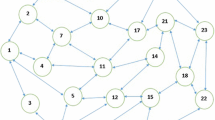Abstract
Optical networks pose real difficulty in finding the flexible optical routing path for high speed data transmission in optical communication network environment because of critical path, blocking performance, and security; processing delay, etc., to overcome this pitfall, a new algorithm fuzzy graph based ranking has been proposed. In this algorithm contain two schemes that are: fuzzy and graph theory, for this work we consider the distance and processing time, these two parameters are represented by fuzzy numbers and fuzzy triangular numbers, those values are used to find the shortest path from the different paths. In this paper observed that fuzzy graph based alternate routing scheme provided for better routing performance. In addition to that, the simulated results show that the network, performance can be improved when alternative routes are used in optical router architecture and also illustrate the numerical example of shortest path and fuzzy graph theory has been surveyed. The definite architecture for optical router and analytical approach is given in this paper, It helps that the researchers to improve the optical routing capabilities according to the fulfillment of present needs better analysis and simulation report shows that proposed method provides an optimized route in the optical network over the existing algorithms. The objectives of this paper, to minimize the processing delay of finding the shortest path (optimum path) and attain higher throughput.




Similar content being viewed by others
References
Abbasi, S., Moosavi, F.: Finding shortest path in static networks: using a modified algorithm. Int. J. Financ. Bank. Stud. IJFBS 1(1), 29–34 (2012)
An, J., Pangalos, P., Aghvami, A.H.: Novel fuzzy non-dominance shortest path routing and path ordering for QoS aware routing. In: IEEE-24th International Symposium on Personal, Indoor and Mobile Radio Communications: Mobile and Wireless Networks, pp. 3381–3385 (2013)
Bhanja, U., Mishra, D.: Dynamic routing and wavelength assignment using fuzzy logic controller in WDM optical networks. In: International Conference on Signal Processing and Communication (ICSC), IEEE, pp. 380–385 (2015)
Biswas, S.S., Alam, B., Doja, M.N.: An algorithm for extracting intuitionistic fuzzy shortest path in a graph. Appl. Comput. Intell. Soft Comput. 2013(17), 1–5 (2013)
Boominathan, P., Kanchan, A.: Routing planning as an application of graph theory. Int. J. Sci. Technol. Res. 3(6), 61–66 (2014). (ISSN 2277-8616)
Caha, J., Dvorsky, J.: Optimal path problem with possibilistic weights. In: Ivan, I., Benenson, I., Jiang, B., Horák, J., Haworth, J., Inspektor, T. (eds.) Geoinformatics For Intelligent Transportation, pp. 39–50. Springer, Cham (2014)
Cho, H., Park, J., Gil, J.M., Jeong, Y.S., Park, J.H.: An optimal path computation architecture for the cloud-network on software-defined networking. Sustainability 7, 5413–5430 (2015). (ISSN 2071-1050)
Kavitha, T., Rajamani, V.: Efficient multipath routing and wavelength allocation using traffic grooming in optical wavelength division multiplexing mesh networks. J. Comput. Sci. 8(11), 1839–1848 (2012)
Khandelwal, G., Prasanna, G., Hota, C.: Probabilistic routing using queuing theory for manets. Int. J. Wirel. Mobile Netw. (IJWMN) 3(4), 144–158 (2011)
Koubaa, M., Amdouni, N., Aguili, T.: Efficient traffic engineering strategies for optimizing network throughput in WDM all optical networks. Int. J. Comput. Netw. Inf. Secur. 6, 39–49 (2015)
Kumar, A., Kaunr, M.: A new algorithm for solving network flow problems with fuzzy arc lengths. TJFS 2(1), 1–13 (2011). (eISSN: 1309–1190)
Kusetogullari, H., Sharif, M.H., Leeson, M.S., Celik, T.: A reduced uncertainty based hybrid evolutionary algorithm for solving dynamic shortest-path routing problem. J. Circuits Syst. Comput. 24(5), 1–38 (2014)
Marzo, J.L., Aguirre, D., Rueda, D., Fabrega, L., Calle, E., Vila, P.: Greedy geometric routing and robustness measurements in large-scale networks. In: Proceedings workshop New Paradigms for Routing in Optical Networks, pp. 46–50 (2014). http://webcache.googleusercontent.com/search?q=cache:HbmL1SLNaa8J:cursos.larc.usp.br
Mohan Kumar, S., Jagadeesha, S.N.: A minimum reconfiguration probability routing algorithm for RWA in all-optical networks. Signal Image Process. Int. J. 7(6), 39–51 (2016)
Padmaja, B., Satheesh, R., Dhanasree, K.: Shortest path finding using spatial ranking. Int. J. Comput. Eng. Res. 2(5), 1186–1189 (2012)
Ponraj, R., Amalanathan, G.: Dyanmic capacity routing in networks with MTSP. Int. J. Comput. Commun. Eng. 5(6), 465–472 (2016)
Selim, H., Zhan, J.: Towards shortest path identification on large networks. J. Big Data 3(1), 1–18 (2016)
Sharma, P., Planiya, A.: Shortest path finding of wireless optical network using Dijkstra algorithm and analysis of delay and blocking probability. IJRSI’16 3(4), 77–84 (2016)
Tajdin, A., Mahdavi, I., Mahdavi-Amiri, N., Sadeghpour-Gildeh, B., Hassanzadeh, R.: A novel approach for finding a shortest path in a mixed fuzzy network. Wirel. Sens. Netw. 2, 148–160 (2010)
Yamani, O.E., Mouncif, H., Rida, M.: A fuzzy TOPSIS approach for finding shortest path in multimodal transportation networks. Int. J. Comput. Optim. 1(2), 95–111 (2014)
Author information
Authors and Affiliations
Corresponding author
Rights and permissions
About this article
Cite this article
Adaikalam, A., Manikandan, S. & Rajamani, V. Fuzzy graph based shortest path ranking method for optical network. Opt Quant Electron 49, 296 (2017). https://doi.org/10.1007/s11082-017-1134-0
Received:
Accepted:
Published:
DOI: https://doi.org/10.1007/s11082-017-1134-0




